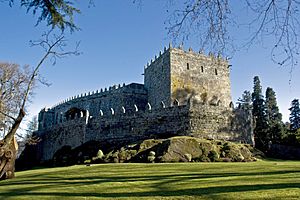Pedro Madruga facts for kids
Quick facts for kids
Pedro Álvarez de Soutomaior
|
|
|---|---|
| Count of Caminha Viscount of Tuy |
|

Soutomaior Castle, the ancestral home of Pedro Madruga
|
|
| Full name |
Pedro Álvarez de Soutomaior
|
| Born | c. 1430 Pontevedra, Galicia |
| Died | 1486 Alba de Tormes, Castile |
| Residence | Soutomaior Castle |
| Wars and battles | Irmandiño revolts War of the Castilian Succession |
| Spouse(s) | Teresa de Távora |
| Father | Fernán Eanes de Sotomaior |
| Mother | Constança Gonçalves (?) |
Pedro Álvarez de Soutomaior (born around 1430, died 1486) was a powerful nobleman and knight from Galicia, a region in Spain. He was often called Pedro Madruga.
Pedro Madruga was an important person in Galicia. He also had influence in the royal courts of Portugal and Castile. He helped stop the Irmandiño peasant revolts in the 1460s. Later, he fought to support Joanna la Beltraneja in the War of the Castilian Succession. Joanna was a claimant to the Castilian throne, supported by Portugal.
Contents
Pedro Madruga's Family Life
Pedro was the son of Fernán Eanes de Soutomaior. His mother's name is not known for sure. When his father died, his older brother, Alvaro, was supposed to inherit everything.
However, Alvaro died young and had no children. So, Pedro was allowed to inherit the family lands instead. The kings of Castile and Portugal officially recognized him as a legitimate noble. He then became known as Don Pedro Alvarez de Sotomayor.
Pedro married Teresa de Távora, who came from a noble family in Portugal. One of their children was Cristóbal de Sotomayor. Cristóbal later sailed to the West Indies with Diego Columbus, who was the son of Christopher Columbus. Cristóbal even became the governor of Puerto Rico.
The main family home for Pedro was Soutomaior Castle. But he also spent time living at the royal courts in Castile and Portugal.
Why He Was Called "Madruga"
Pedro Álvarez de Sotomayor got his nickname "Madruga" because he liked to "rise early" in the morning. In Spanish, "madrugar" means to get up early.
There's a famous story about how he got this name. Pedro had a disagreement with the Count of Ribadavia about where their lands ended. To solve the problem, they agreed to a challenge. They would both get on their horses at the first sound of a rooster crowing. Then, they would ride towards each other's castle. The spot where they met would become the new border.
But Pedro was very clever! He decided that the "first cockcrow" happened at midnight. So, he rode all through the night. By the time the Count woke up at dawn, Pedro was already standing at his castle door! The Count was surprised and exclaimed, "Madrugas Pedro, madrugas!" This means, "You're an early riser, Pedro; an early riser!" And that's how he got his famous nickname.
Pedro Madruga's Important Actions
Pedro Madruga was an important person in the court of Henry IV of Castile, who was the king. The king trusted Pedro to help keep a powerful bishop, Alonso de Fonseca, in check.
In the 1460s, a big peasant uprising happened in Galicia. This was called the second Irmandiño revolt. The peasants were rebelling against the nobles. Pedro Madruga had to go to Portugal for safety. But the other nobles asked for his help. He gathered an army and fought against the Irmandiños many times. He eventually managed to stop their rebellion.
Later, in the 1470s, there was a war called the War of the Castilian Succession. Pedro Madruga supported Joanna la Beltraneja. She was the daughter of King Henry IV and wanted to be queen. Pedro fought against the claims of Isabella I of Castile and Ferdinand, who later became known as the Catholic Monarchs.
What People Thought of Pedro Madruga
Pedro Madruga was known as a strong and active leader. He made a big impact on Galicia during the troubled 1400s. Even so, he was very popular among the people of Galicia. They even had a special saying to remember him:
Long live the palm, long live the flower
Long live Pedro Madruga
Pedro Madruga de Sotomayor.
Was Pedro Madruga Christopher Columbus?
In the late 1800s, a Spanish writer named García de la Riega suggested a new idea. He thought that Christopher Columbus might have been from Galicia. This idea was popular for a while but later faded.
However, in recent years, a new theory has come up: What if Pedro Madruga and Christopher Columbus were the same person? This theory suggests that Pedro Madruga did not die in 1486. Instead, he changed his identity. This might have been to hide a secret agreement between him and his former enemies, the Catholic Monarchs.
People who believe this theory point to a few things:
- Columbus named many places in the West Indies after more than 100 towns near Soutomaior in Galicia.
- The handwriting of Columbus and Pedro Madruga looks very similar.
One argument against this theory is a will written in 1491 by Alvaro de Sotomayor, Pedro Madruga's oldest son. In this document, Alvaro says that his parents' bones should be moved to the Cathedral Church of Tuy. This suggests that Pedro Madruga was already dead by 1491, even if not in 1486.
Pedro Madruga's Titles
See also
 In Spanish: Pedro Madruga para niños
In Spanish: Pedro Madruga para niños

